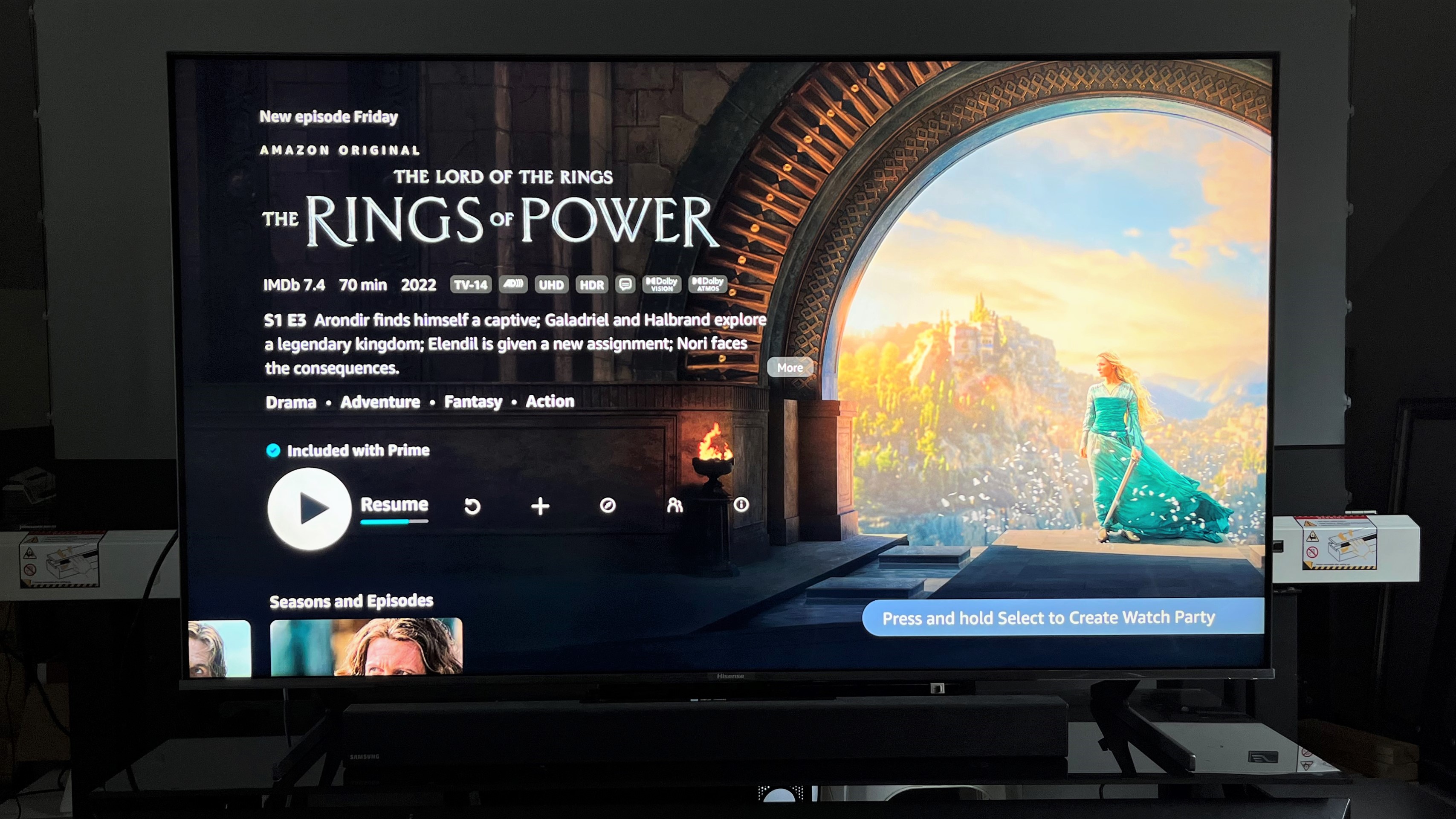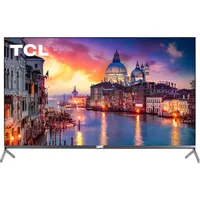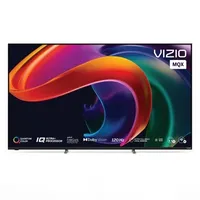TechRadar Verdict
The Hisense U8H is the latest model to arrive from the budget TV maker and represents an attempt to pack as many features as possible into a set that’s very competitively priced. With a mini-LED backlight, the U8H delivers high brightness along with rich color courtesy of Quantum Dots. It’s also a fine match for next-gen gaming consoles, with features like 120 Hz display, VRR, and ALLM on tap. Budget TVs keep getting better and better – a bit of good news during a time when people have less money to spend – and the Hisense U8H is a perfect example of that trend.
Pros
- +
Deep blacks and strong brightness
- +
Rich color
- +
120 Hz, VRR, and ALLM for gaming
Cons
- -
Some backlight blooming
- -
Upconverted HD images can look soft
- -
Just average audio performance
Why you can trust TechRadar
Hisense U8H: One-minute review
Hisense battles with TCL, Vizio, and other budget TV makers for the attention of cost-conscious buyers, and with its new U8H series, the company has succeeded in stepping up its game to fully compete with those brands.
The U8H series’ chief claim to fame is its mini-LED backlight, a feature first implemented in LCD TVs by rival TCL that was quickly adopted by Samsung, LG, and Sony in their own sets. A major benefit to mini-LED is high brightness – something the U8H series readily delivers.
But high brightness isn’t the only thing about the U8H that impresses. It uses a Quantum Dot filter for enhanced color, and the 504 local dimming zones on the 65-inch model deliver deep and detailed blacks. (According to Hisense, the 65-inch U8H model sold in the UK has 160 dimming zones, and it also uses an IPS panel as opposed to the VA one found in the US version.) Some backlight blooming – a typical artifact with LED-backlit TVs that feature local dimming – can be seen with challenging material, but that’s the exception rather than the norm.
With support for Dolby Vision IQ, HDR10+ Adaptive, and HLG, the U8H series is ready for any HDR format you stream or feed to it, and it also has a Filmmaker mode that provides mostly accurate out-of-box color. Another impressive aspect of the U8H is its extensive support for next-gen gaming consoles: along with 120 Hz display, it offers Variable Refresh Rate (VRR), Auto Low Latency Mode (ALLM), and FreeSync Premium Pro.
While the UH8 has Dolby Atmos processing and a built-in subwoofer to supplement its main speakers, audio performance is just average for a TV, and we’d recommend using it with a soundbar or other external audio solution.
The set’s overall design is pleasing and it comes with an adequate remote control and feet that can be adjusted to better accommodate a soundbar when placed on a TV stand. Hisense uses Google TV as the smart interface for the UH8, and it’s a mostly fine way to go, especially if you sign in as a Google user. This will allow you to tap Google Assistant for all sorts of smart home actions, and will also let you carry out basic functions and content searches using voice commands.
There’s a lot to say about U8H series, but the key takeaway is that Hisense provides great value here. While it doesn’t offer the same level of perfection as top OLED TVs, it bests them in terms of peak brightness, and the overall picture quality is great for the price. Add to that a fully loaded feature set, and the U8H is a TV option well worth consideration.
Sign up for breaking news, reviews, opinion, top tech deals, and more.
Hisense U8H review: price and release date
- Release date: July 7, 2022
- 55U8H: $1,149 / £999 / AU$2,299
- 65U8H: $1,399 / £1,499 / AU$2,799
- 75U8H: $1,499 / £1,999 / AU$3,999
Hisense’s U8H series TVs are available in the US, the UK, and globally. The company’s sets are aimed at the budget-conscious buyer and they mainly compete with brands like TCL and Vizio.
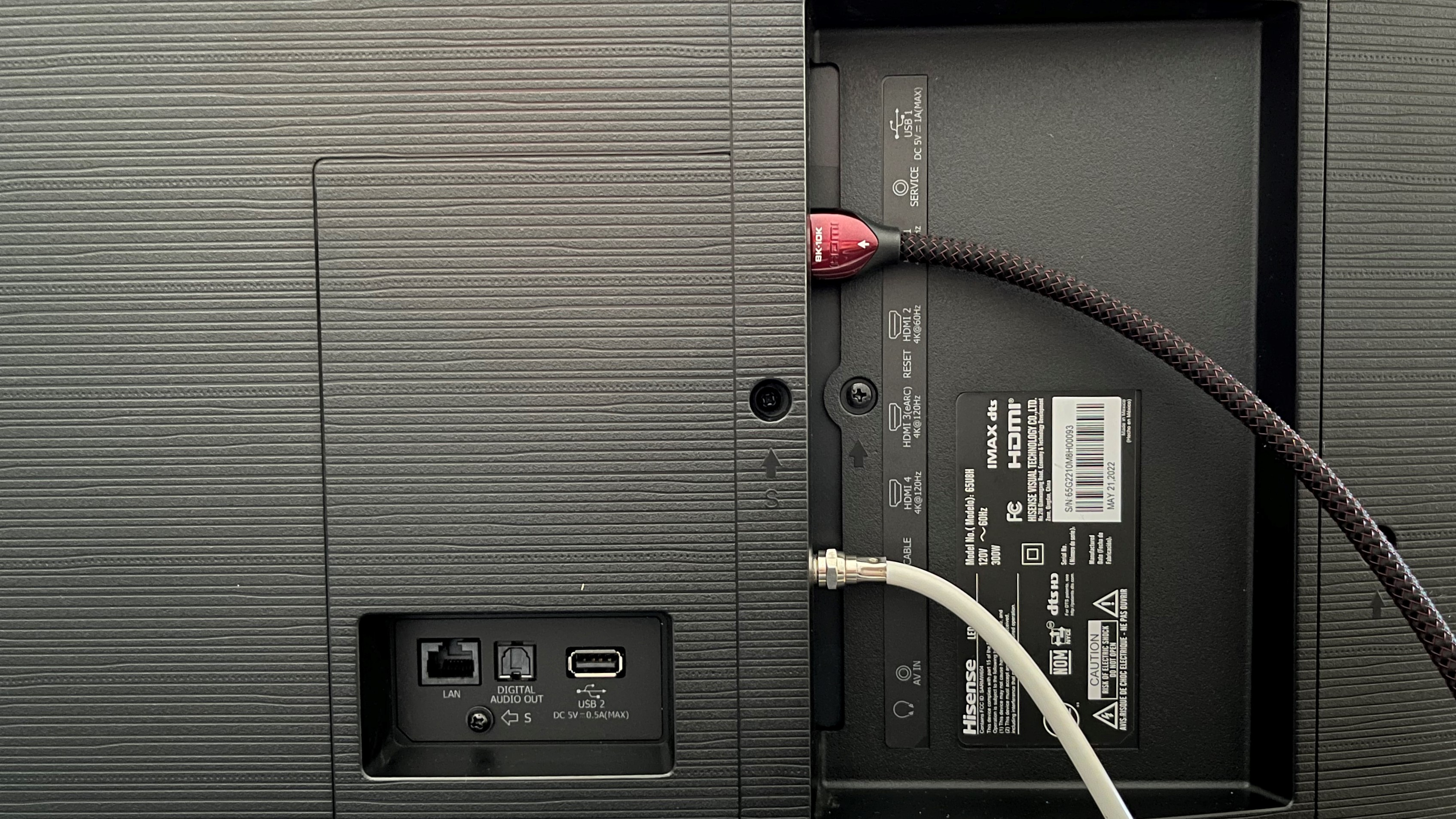
Hisense U8H review: features
- Full-array mini-LED backlight with local dimming (336 zones)
- Dolby Vision IQ, HDR10, HDR10+ Adaptive, and HLG high dynamic range
- HDMI 2.1 inputs with 4K/120Hz, variable refresh rate (VRR), auto low latency mode (ALLM), and enhanced audio return channel (eARC)
- Filmmaker mode
- FreeSync Premium Pro
- Casting via Chromecast Built-in
- Works with Alexa and Google Assistant
- Bluetooth audio input
Hisense’s U8H series TVs feature a full-array mini-LED backlight, with 504 zones on the 65-inch model we tested. The set’s LCD panel uses a Quantum Dot layer for enhanced color, and the Dolby Vision IQ, HDR10, HDR10+ Adaptive, and HLG high dynamic range formats are all supported.
A total of four HDMI inputs are provided, with two offering HDMI 2.1 features such as 4K/120Hz support, variable refresh rate (VRR), and auto low latency mode (ALLM). Other gamer-friendly features include Freesync Premium Pro, and there’s also HDMI eARC support.
U8H series TVs use the Google TV smart interface for streaming and the wide selection of available apps include Netflix, Amazon Prime, Disney+, Hulu, HBO Max, Apple TV+, and ESPN+. There are also free TV apps like Tubi and Pluto TV, and the set’s built-in ATSC 3.0 tuner gives US owners even more opportunities to view free channels by plugging in a digital TV antenna.
Beyond streaming, there’s Google Assistant for voice control, recommendations, and searches, and the set also works with Alexa. You can access Google Assistant by pressing a button on the U8H’s remote control to activate its built-in mic and there are also dedictated buttons on the remote to directly call up various streaming services.
Like other sets with Google TV, you can use Chromecast built-in to cast content from compatible apps to the TV from a phone or tablet. Bluetooth audio streaming is also supported, but there’s no Bluetooth output for listening with wireless headphones.
Overall, the U8H is feature-packed, its mini-LED backlight standing out in particular as a compelling bonus in a relatively low-cost TV.
- Features Score: 4.5/5
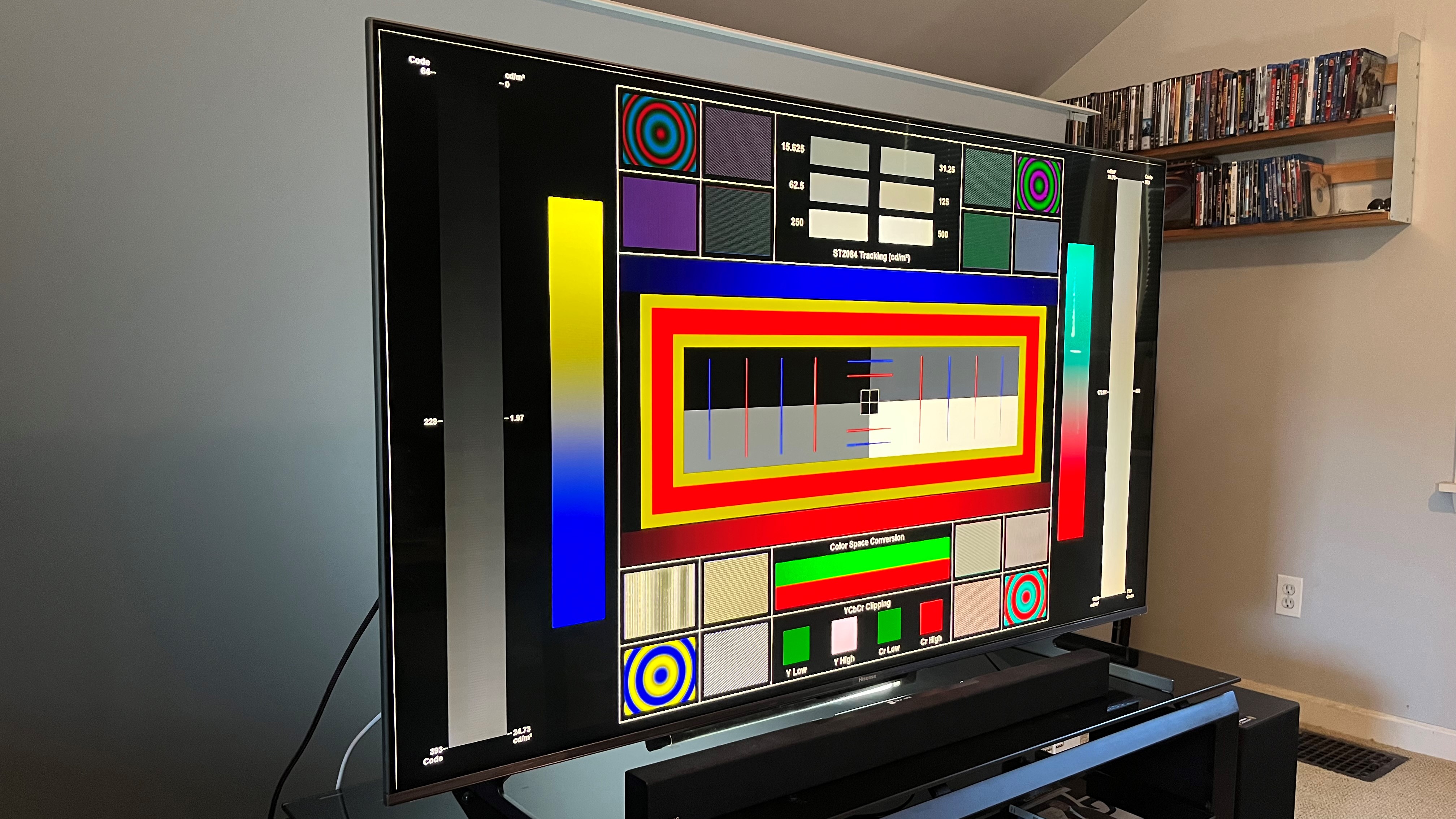
Hisense U8H review: picture quality
- Very good brightness
- Deep blacks and strong contrast
- Rich, accurate color
With a set sporting a mini-LED backlight you'll expect pictures to be plenty bright, and here the U8H delivers. Hisense’s specified light output is 1,500 nits, but we measured brightness at 1,775 nits (on a 10% white window pattern), which is close to the 2,000-plus nits that TVs twice the U8H’s price can deliver. Switching over to Filmmaker mode, the set’s most accurate out-of-box picture preset, brightness still measured an impressive 905 nits.
Contrast was also one of the U8H’s strong points, with the set’s local dimming processing shutting off backlight zones completely when displaying full black images to provide an “infinite” contrast ratio. In general, blacks on the TV were satisfyingly deep with most movies, though there was a degree of light “blooming” visible on high-contrast images like white movie credits against a black background. For most of our viewing, we left local dimming at its medium setting, which allowed for a good mix of solid blacks and punchy white highlights.
The U8H’s coverage of DCI-P3, the color gamut used for mastering movies for digital cinema and 4K Blu-ray disc, was 97% when measured using Portrait Displays’ Calman color calibration software. And while we’ve logged higher coverage on sets like Sony’s A80K OLED, the Hisense’s performance here is impressive for budget TV.
Screen uniformity was very good on the U8H, with full screen gray test patterns showing little in the way of uneven brightness or color tinting. With the set’s local dimming feature turned off, there was uneven light distribution visible on full-black images, though enabling local dimming solved that issue at all settings.
Same as with most other LCD-based TVs, both contrast and color saturation took a hit when viewing from off-center seats. The set’s ability to filter out light was good, however, with only minimal reflections from overhead lamps or open windows showing up onscreen.
For everyday viewing, the U8H’s ample brightness proved to be a great benefit – the picture was easily able to compete with daylight, and I didn’t feel a need to dim lamps or draw curtains.
Screen size: 55, 65, 75 inches
Resolution: 4K
Panel technology: QLED
HDR support: Dolby Vision IQ, HDR10, HDR10+ Adaptive, HLG
Audio support: Dolby Atmos, Dolby Digital
Smart TV: Google TV
HDMI ports: 4 (2 version 2.1)
During more critical viewing, U8H was able to flesh out a full range of rich gray tones on the Criterion Collection Blu-ray of David Lynch’s The Elephant Man. Black depth and shadow detail when watching this disc were also very good, though I did note a degree of backlight blooming in regular scenes along with the title sequence. This mostly showed up as elevated brightness in the black letterbox bars of widescreen movies. Regular high-definition programs also looked a bit soft on the U8H compared to other TVs, indicating that the video upscaling isn’t as good as what you’d get from pricier sets.
Given the U8H’s very good measured color performance, I wasn’t surprised that shows like Amazon’s The Lord of the Rings: The Rings of Power looked strikingly good. This series offers up sumptuous visuals, and Hisense’s set was able to easily convey the rich range of colors and and crisp 4K detail.
Watching a more familiar test disc for color, Guardians of the Galaxy Vol.2, the psychedelic palette of the scenes that take place on Ego’s home planet were rendered in a clean, yet fully saturated way. The few human faces revealed natural-looking skin tones, and the U8H’s combination of powerful brightness and well-modulated contrast could be appreciated in the overall dynamic and vibrant quality of images.
To check out the Hisense’s handling of Dolby Vision high dynamic range, I watched a few scenes from the Bond film No Time to Die. In an early scene where Daniel Craig and Léa Seydoux check into an Italian villa while people toss flaming papers into the air, the contrast between the burning notes and nighttime sky gave the image a strong sense of depth. Another, later scene from No Time to Die where Craig walks through a rugged landscape with the camera panning across it revealed very good motion processing, with the texture of the grass and rocks remaining mostly solid.
With its bright, daylight-friendly picture, the U8H is a great option for sports viewing. When I streamed an Athletic Club vs Almeria soccer match on ESPN+, the set’s impressive motion handling ensured that details in the image remained solid, even with players running across the field and fans waving large flags. One bit of related advice: do not turn on the Motion Clearness setting for sports viewing. This setting served to effectively halve the set’s brightness while not offering up any visible motion resolution benefit.
- Picture quality score: 4/5
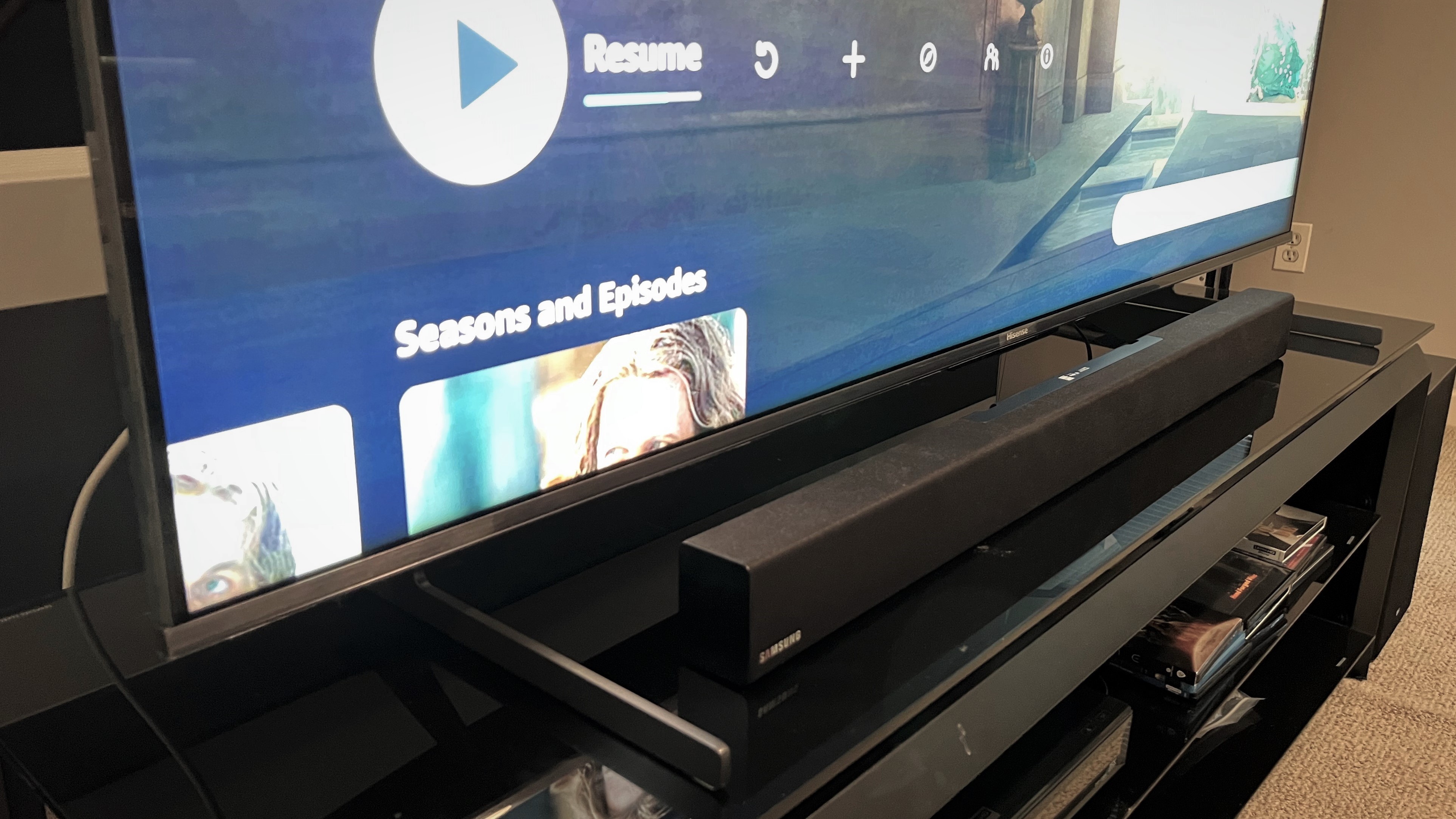
Hisense U8H review: sound quality
- 10 watts x 2 plus 20 watts for sub
- Average sound quality
- Limited bass from “subwoofer”
The U8H’s built-in 2 x 10-watt speakers are augmented by a built-in “subwoofer” that’s mounted on the set’s back panel. Dolby Atmos support is onboard and it can also be disabled in the set’s audio setup menu. Other menu settings give you the option to boost or cut sub output and equalize the rest of the audio frequency range.
Despite having both Dolby Atmos and a built-in sub, the U8H’s sound quality was just average. I didn’t note any Atmos height effects (not that I was expecting it from a flat-panel TV) and the sound lacked dynamics even when pushed to a loud level. That sub’s contribution was also pretty minimal, with not much in the way of bass effects coming from the TV. Dialogue was clear for the most part, however, so you could get away with not using a soundbar here if that’s your preference.
- Sound quality score: 3/5
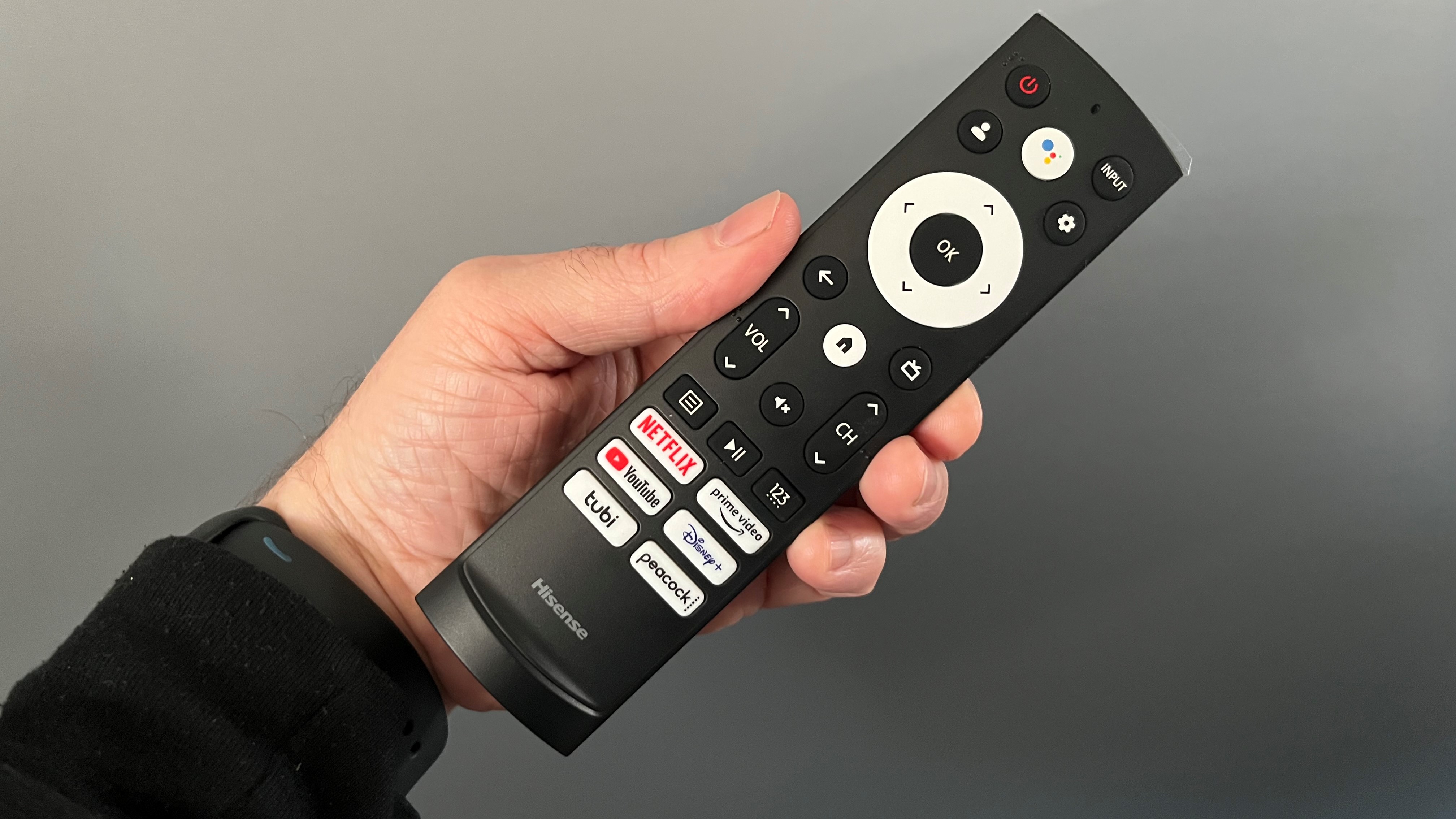
Hisense U8H review: design
- Slim design
- Adjustable feet can accommodate a soundbar
- Basic remote control
Despite having a built-in, back-mounted subwoofer, the U8H’s cabinet is slim and its screen is framed by an extremely thin, silvery bezel. Most connections are made on an inset panel located around back, which contains the set’s 4 HDMI jacks along with an antenna input and powered USB port. A second, back-facing panel provides additional connections, including optical digital audio and both powered USB and Ethernet ports.
The TV’s sturdy metal feet can be installed either closer in toward the screen’s center or extended further out to the sides. The latter option gives you ample space for soundbar placement, and the 3 inches of clearance between the TV’s bottom edge and the surface it’s placed upon means there's plenty of space for a soundbar.
The basic remote control that comes with the TV lacks a backlit keypad but has rubbery buttons that are marked with bright white text and symbols, making it more than usable in a dim room. Six buttons at the bottom give you direct access to the Netflix, Prime Video, YouTube, Disney+, Tubi, and Peacock streaming services. Also, a Google Assistant button at the top lets you speak commands directly into the remote for more advanced operations like content search.
- Design score: 3.5/5

Hisense U8H review: smart TV & menus
- Google TV interface
- Voice searches using remote
- Picture adjustments easily accessible from menus
The Hisense’s Google TV interface is the same one that comes with TVs from other brands like Sony and TCL. Basically every app you could want is either here or available for download from the Google Store, and you get the option to sign in with Google credentials to unlock personalized features like viewing recommendations and Google Photo streams.
Google Assistant works well to command things like specific volume adjustments (Hey Google, reduce volume to 50%), content searches (show me 1980s horror films I can watch for free), and even input selection (switch to Blu-ray player input). And while Google is definitely pushing movies you can watch free (with ads, of course) on its own YouTube channel (these show up in a big window at the top of the TV interface), the general content recommendations seemed to sync up pretty well, revealing, for better or worse, a high level of familiarity.
All picture and sound adjustments (aside from volume and mute) must be accessed from their repective setup menus. On the picture side, along with local dimming there are advanced settings to tweak gamma and white balance, as well as a full color management system, although those adjustments are best left to calibration professionals. Regular viewers interested in getting the best picture quality for movies would do well to start with Filmmaker mode, and any adjustments you make there can also be applied to the set’s other inputs.
- Smart TV & menus score: 3.5/5

Hisense U8H review: gaming
- HDMI 2.1 with 4K/120Hz, VRR, and ALLM support
- FreeSync Premium Pro
- Low 11.2ms input lag in Game mode
While Hisense doesn’t specifically pitch the U8H as a gaming TV, its 4K/120Hz, VRR, and ALLM support, along with FreeSync Premium Pro, make it one of the better set options for gaming, particularly in its price class. Aside from a Game picture mode, there’s not much in the way of related menu adjustments, though there is an HDR picture mode for gaming.
We measured the Hisense’s input lag at 111ms in Filmmaker mode and an impressive 11.2ms in Game mode, a result that puts the Hisense in the same league as the best 120 Hz 4K TVs for next-gen gaming.
- Gaming score: 4/5
Hisense U8H review: value
- Great overall performance for a budget TV
- Costs much less than an OLED while offering better brightness
- Low price for a mini-LED backlit model
Hisense is known for making low-cost TVs, but a low price doesn’t always mean a good value. With its powerful brightness and overall very good picture quality, strong feature set including wide-ranging support for next-gen gaming consoles, and affordable price, the U8H counts as an excellent overall value.
Is the Hisense U8H the best value around? Vizio’s M-Series QX TVs offer mosly similar performance (though lower brightness from a standard LED backlight rather than mini-LED) at a lower price. And TCL’s 6-Series mini-LED-backlit TVs are also priced lower than the Hisense, though their performance lags somewhat behind the U8H series and they are comparatively light on gaming features.
Most OLED TVs with the same screen size will cost around twice as much as the U8H while offering considerably lower picture brightness. So if that specific attribute is important to you, you will find the value proposition of Hisense’s U8H to be irresistible.
- Value score: 5/5
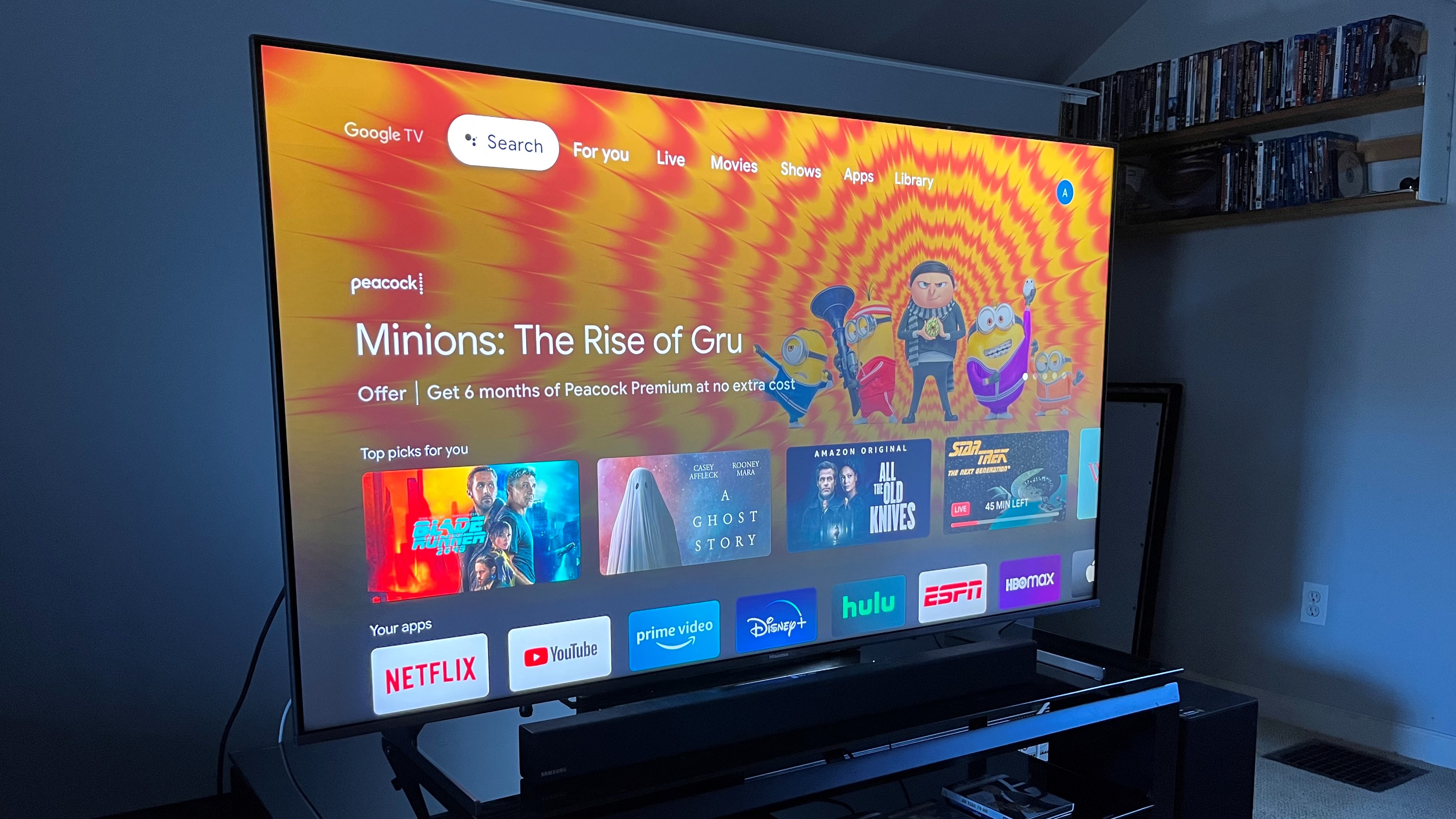
Should I buy the Hisense U8H?
| Attributes | Notes | Rating |
|---|---|---|
| Features | Dolby Vision IQ and HDR10+ Adaptive HDR support, along with HDMI 2.1 features like 4K/120Hz, VRR, and ALLM. | 4.5/5 |
| Picture quality | A mini-LED backlight delivers very good brightness and contrast, and color is rich for a budget TV. | 4/5 |
| Sound quality | Just-average audio performance means you should add a soundbar. | 3/5 |
| Design | Good overall design enhanced by an adjustable stand. | 3.5/5 |
| Smart TV and menus | Google TV smart interface is mostly good, and there's a decent range of picture adjustments. | 3.5/5 |
| Gaming | 120 Hz, VRR, ALLM, and FreeSync Premium Pro all make this a great choice for gaming. | 4/5 |
| Value | An excellent overall value. | 5/5 |
Buy it if...
You want a set bright enough for daylight viewing
The U8H’s mini-LED backlight is powerful enough to compete with light from lamps and open windows, and it effortlessly delivers HDR highlights.
You want to save money
You could easily spend lots more cash on an OLED or top-tier QLED TV, but the U8H’s combination of features and performance should satisfy most buyers.
You’re into gaming
For a budget set, the U8H offers a complete set of gaming features, including 120 Hz display, VRR, ALLM, and FreeSync Premium Pro.
Don't buy it if...
You expect OLED-level performance
The U8H bests OLED TVs when it comes to peak brightness, but OLED tech is still unmatched when it comes to delivering deep, uniform blacks.
You don’t want to use Google TV
While it’s not necessary to sign in to Google TV on the U8H, you’ll need to do so to make the most of the set’s smart features.
You refuse to spring for a soundbar
While the U8H’s audio is adequate, and the TV even has a built-in subwoofer, its sound lacks much of the dynamic quality you can get with an external soundbar.
Also consider
If our Hisense U8H series review has you considering other options, here are three more TVs to ponder.
LG A2
Though slightly more expensive than the Hisense, the 65-inch version of LG’s least pricey OLED TV is distinguished by its excellent picture performance. Gaming features are lacking, though, and the peak brightness is substantially less.
TCL 6-Series
Another budget QLED TV with a mini-LED backlight, the TCL 65R635 offers good all-around performance and uses the tried-and-true Roku TV platform for streaming. But it lacks the gaming features found on the Hisense, and it can’t match it when it comes to peak brightness.
Vizio M-Series QX
Vizio’s 65-inch M-Series QX QLED TV is priced even lower than the Hisense 65U8H, but offers many of the same gaming features, along with very good overall performance. Peak brightness is limited in comparison, however, and it lacks the Hisense’s mini-LED backlight.

Al Griffin has been writing about and reviewing A/V tech since the days LaserDiscs roamed the earth, and was previously the editor of Sound & Vision magazine.
When not reviewing the latest and greatest gear or watching movies at home, he can usually be found out and about on a bike.
